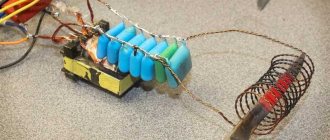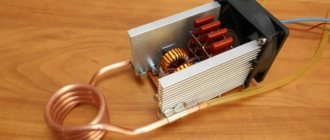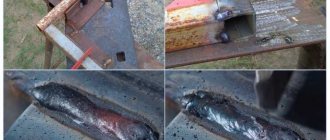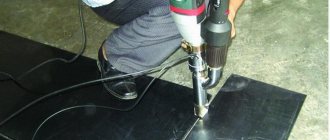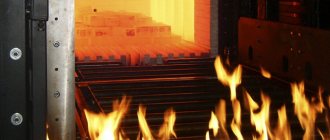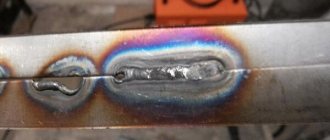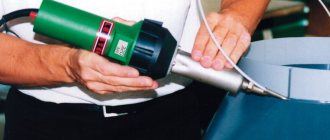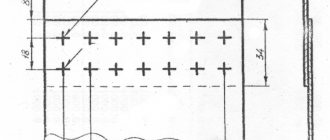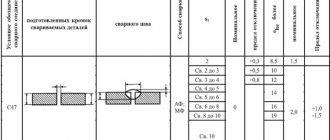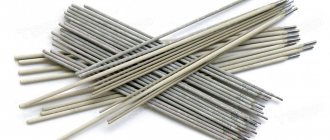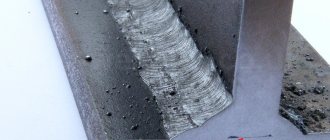The use of such equipment allows you to literally heat the parts to the required temperature in just a few seconds, at which the metal becomes soft and easy to weld. There is a large selection of equipment for induction heating of metal workpieces on sale. Models differ in power, operating voltage and current frequency, cost, design features and other criteria. You can easily select an induction heating device that meets your specific requirements and suits your price.
Inductor device
Equipment for induction heating of metals has a prefabricated design. It consists of two main components - the inductor itself, as well as a generating unit that produces high-frequency current pulses.
An inductor is an ordinary inductor consisting of several turns of a copper conductor. For the production of these components, only oxygen-free copper is used, in which the content of foreign impurities should not exceed 0.1%. This device can have different diameters (from 16 to 250 mm depending on the model). The number of turns varies from 1 to 4.
The generator that produces pulsed currents for the induction heating coil has quite impressive dimensions and weight. It can be implemented using any high-frequency pulse generation scheme. For example, in modern industry, generating units built on the basis of multivibrators, RC generators, relaxation circuits, etc. are often used.
If the equipment is used primarily for heating small parts, the frequency of the generated pulses must be at least 5 MHz. These units are developed on the basis of vacuum tubes. If the technique is used to heat large metal workpieces, it is advisable to use induction units with an operating frequency of up to 300 kHz, built on the basis of inverters based on IGBT circuits or MOSFET transistors.
Operating principle of inductors
Devices for induction heating of metals operate on a simple principle based on the phenomenon of electromagnetic induction. When high-frequency alternating current passes through the coil, a powerful magnetic field is formed around and inside it. It causes the appearance of eddy currents inside the metal workpiece being processed.
Since the part, as a rule, has extremely low electrical resistance, it quickly heats up under the influence of eddy currents. As a result, its temperature increases to such an extent that the metal becomes softer and begins to melt. It is at this moment that the ends of the workpieces being processed are welded.
Page 1 of 2
Induction welding is a technology for welding metal parts by heating the surfaces to be welded under the influence of an induced current. In other words, this is a type of welding in which electromagnetic induction is used to heat the workpieces being welded.
An induction welding machine has an induction coil that is excited by high frequency electric current. It generates a high-frequency electromagnetic field that affects a workpiece of either conductive or ferromagnetic material. In a workpiece made of conductive material, the main type of heating is resistive heating caused by induced (eddy) currents.
In a workpiece made of ferromagnetic material, heating occurs mainly under the influence of hysteresis, since the electromagnetic field cyclically remagnetizes regions of spontaneous unidirectional magnetization (the so-called “domains”) of the ferromagnetic material. In practice, most materials are subject to a combination of resistive heating and hysteresis.
Non-magnetic and electrically insulating materials, such as plastics, can be induction welded by implanting metal or ferromagnetic mixtures inside them, so-called induction current receivers, which take electromagnetic energy from an induction coil, heat up and, due to thermal conductivity, give off their heat to the surrounding material.
Induction welding is a highly automated process that is used to make long, single-pass welds (typically longitudinal pipe welds). The induction welding process can be carried out very quickly, since a large amount of energy can be transferred to the welding site, which ensures very rapid melting of the mating surfaces during welding and the ability to press them together to obtain a continuous weld.
The depth to which induced currents, and therefore heat, penetrate into the material is inversely proportional to the square root of the frequency of the currents. The penetration depth of induced currents is also affected by the temperature and chemical composition of the metals being welded. Induction welding is very similar to resistance welding, however, with resistance welding, electric current appears in the workpiece as a result of contact between it and the welding electrodes, and not due to electromagnetic induction.
<< First < Previous 1 Next > Last >>
| < Previous | Next > |
Main types of inductors
In modern industry, three types of units for induction heating of metal parts are widespread:
- tubular. Externally, such devices resemble household boilers. Inductors consist of 2, 3 or 4 turns of copper conductor, the surface of which is treated with a special protective coating. These units are used for induction heating of small parts. The internal diameters of the working elements, as a rule, vary from 16 to 90 mm;
- tape A distinctive feature of this type of equipment is the increased internal diameter. This parameter can vary from 28 to 250 mm. Most tape inductor models consist of 1 or 2 turns. The turns are placed in a protective tape sheath;
- prefabricated Equipment of this type is used for induction heating of large metal workpieces. The internal diameter of the working elements ranges from 70 to 610 mm. The heating power for some models of these devices can reach 400 kW;
Advantages of induction heating
Induction heating technology has several advantages.
- Induction equipment allows you to quickly heat and melt any metal parts. In this case, heat treatment of workpieces can be carried out tens of times faster than when using gas burners. The induction unit allows you to obtain the desired temperature of the part in just a few seconds.
- Heating can be carried out in various environments. For example, an induction unit together with a workpiece can be placed in a protective gas atmosphere, an oxidizing or reducing environment, a liquid, and even a vacuum. Standard gas heating devices cannot be used in such conditions.
- The induction heating process occurs solely due to the thermal energy that is released when eddy currents pass through the workpiece. Therefore, the surface of the part is not contaminated with torch combustion products (as with gas-flame heating) or with electrode substances (as with arc welding).
- Induction heating units can be used in any environment, even in poorly ventilated and enclosed areas. This is due to the fact that during operation such equipment does not pollute the surrounding air with combustion products.
- Inductors can be used for local and selective heating of workpieces, in which it is necessary to increase the temperature of not the entire part, but its individual parts.
mtomd.info
Induction welding of metals
During induction welding (IC), parts are heated either by eddy currents induced by a magnetic field created by an inductor located close to the product, connected to the generator with high-frequency currents (induction circuit), or by flowing current in the case when the product is connected directly to the high-frequency generator circuit (conduction circuit). current supply diagram).
This method can be used to join ferrous and non-ferrous metals and their alloys, as well as plastics and synthetic fabrics. With induction current supply, the pipes to be connected pass in front of the crimping rollers in close proximity to the transformer or inductor. Two edges of the pipe, located on diametrically opposite sides, move towards each other at a certain angle, forming a V-shaped slot. When passing under the inductor, eddy currents are induced in the parts being welded, directed opposite to the current in the inductor. Encountering a V-shaped slot on its way, the current is deflected to the top of the convergence angle. Due to the proximity effect and the surface effect, the current is concentrated mainly on the welded areas of the surfaces facing each other, thereby ensuring rapid heating of the metal to the welding temperature. Pressure rollers ensure contact between the pipe edges being welded. The welded edges must be processed to a metallic shine (mill scale is allowed), but noticeable irregularities are not allowed on them.
To increase the heating efficiency, a ferromagnetic mass—a ferrite magnetic core—is introduced into the ring inductor (into the tube blank).
Welding according to this scheme is used for products with a closed cross section. It is suitable for continuous sequential seam welding of pipes.
Figure 1 - Induction welding of pipes with a rotating transformer
1 - welding transformer (rotating transformer); 2 - cooling; 3 - insulation; 4 — roller electrodes; 5 - welding seam; 6 — side pressure rollers; 7 - table; 8 - pipe with groove; 9 - welded part of the pipe
Figure 2 shows a diagram of longitudinal welding of pipes with a ring inductor. This method can be used for welding pipes with a diameter of 10-100 mm with a wall thickness of 0.5-15 mm made of low-carbon and high-carbon steels, stainless and acid-resistant steels, pipes made of non-ferrous metals - copper, brass, bronze, aluminum and their alloys.
Figure 2 - Induction welding of pipes with a rod inductor
1 - unwelded part of the pipe; 2 - conductive busbar; 3 - cooling channel; 4 - magnetic yoke; 5 - a pair of pressure rollers; 6 - induction generator; 7 - welded part of the pipe
As the diameter of the pipes increases, the efficiency of the female inductors decreases sharply; the most effective was the supply of current using internal inductors or a combined system using both female and internal inductors simultaneously. The main effect of using internal inductors is associated with the possibility of reducing losses in the body of the pipe blank.
Figure 3 - Induction welding of pipes with a ring inductor
1 - splined pipe; 2 - ring inductor; 3 - magnetic core (used for small diameter pipes); 4 - current flow zone; 5 - a pair of pressure rollers; 6 - high frequency generator; 7 - welded part of the pipe; 8 - water cooling
As a result of high specific pressure, significant flash is formed, which must be removed from the welding zone. With a sequential arrangement of rod inductors of the same or different power, it is possible to carry out preliminary and final heating, as well as welding pipes with large wall thicknesses.
Welding produces high-quality steel pipes in accordance with the delivery conditions for welded steel pipes.
Figure 4 — Induction butt welding of pipes
1 - pipe to be welded; 2 - inductor; 3 - magnetic circuit; 4 - clamps for fixing welded pipes and creating upset
The existing gap between the inductor and the product makes it possible to weld hot-rolled material without special treatment of the surface and ends of the workpiece.
The advantages of induction welding with induction feed are as follows:
- fast heating;
- long service life of the inductor;
- absence of marks, scratches, etc. on the parts being welded under the inductor.
The disadvantages of induction welding include:
- the difficulty of maintaining a uniform gap between the inductor and the surface of the parts being welded;
- relatively high power consumption due to the spreading of current over the surface of the pipe outside the welding zone and the difficulty of concentrating heat in the welding zone.
In contrast to induction current supply, with contact current supply there is a concentrated release of heat in the welding zone.
Contact current supply for continuous welding is most often used in the production of electric welded pipes. This scheme allows you to significantly expand the range of welded products, consume energy more economically, but at the same time you have to take into account the limited resource of current leads. The wear resistance of contacts and the reliability of systems with sliding contacts depend on a number of factors, the most important of which are the contact material, clamping force, cooling conditions, and current.
Figure 5 — Induction welding of pipes with contact electrodes
1 - unwelded part of the pipe; 2 - sliding contact of high frequency current; 3 - current flow zone on the pipe; 4 - a pair of pressure rollers; 5 - high frequency generator; 6 - pipe to be welded; 7 - water cooling
The industrial application of induction welding is mainly associated with pipe production, where this process in many cases replaces resistance and arc welding. Induction welding produces longitudinally welded pipes (from steels, aluminum alloys, brass, etc.) of small and medium diameters (12...150 mm) with a wall thickness of 0.8...6 mm, as well as large diameters (400...600 mm) with a wall thickness up to 8 mm. Along with their main consumers (mechanical engineering and building structures), they are increasingly used in oil and gas production. Thus, in the USA, the production of welded pipes for these purposes reached 30% of the total output; Large capacities for the production of casing and tubing pipes were introduced in Japan. In a number of countries, induction welding is used in the production of straight-seam pipes of large (450...1220 mm) diameter with a wall thickness of up to 16 mm from sheets 12 m long.
Induction welding has become widespread for the production of bimetallic strips up to 14 mm thick and metal sheaths of electrical cables.
At the same time, induction welding is widely used for joining plastics and textile materials.
Disadvantages of technology
The method of induction heating of metal workpieces also has some disadvantages that must be taken into account before starting to work with the equipment.
- Inductors have a rather complex design. To work with them, repair and maintain them, it is necessary to attract qualified specialists who have undergone appropriate training.
- To fully operate induction heating devices, a powerful source of electrical energy is required. It is also necessary to have a special tank and pump to ensure high-quality cooling of the unit.
- Despite the rather compact dimensions of the inductor itself, the entire installation, complete with the generator, takes up a lot of space and is heavy. Therefore, such equipment is unsuitable for work in the field. It is advisable to use it for permanent installation indoors. For field work, it is better to use other types of equipment for heating metal parts.
How induction heating is used in welding
The process of welding metal parts using induction heating devices occurs as follows. The workpieces to be welded are placed inside the turns of the inductor, and a high voltage and frequency current is supplied to it. At this moment, eddy currents arise, as a result of which the parts quickly heat up. The opposite edges of the workpieces to be welded are brought closer to each other, positioning them at a certain angle.
The moment the parts come into contact, a V-shaped gap forms between their edges. Eddy currents generated in the workpieces encounter this gap on their path and are deflected closer to the top of the convergence angle. Due to the surface effect, the electric charge is concentrated at the edges of the parts being welded, and it is at these points that heating occurs more intensely. Ultimately, the edges of the workpieces melt and join together. As they are welded, the position of the parts is leveled to horizontal, the V-shaped gap disappears, and the metal elements are firmly welded to each other.
Induction welding technology
Since products made of durable metals have a high level of inductive resistance, the high-frequency current does not spread around the perimeter, as a result of which the pipes are compressed and welded. The workpieces are connected when they are placed in the inductor. At the moment when the parts to be welded are placed in the inductor, eddy currents are induced at the joint areas, which have the opposite direction to the relative current placed in the inductor.
Passing currents get in the way of the connection gap, and they move towards it. The concentration of current is concentrated mainly on the parts of the surface to be welded, and the metal is quickly heated to the required temperature, which is optimal for welding.

